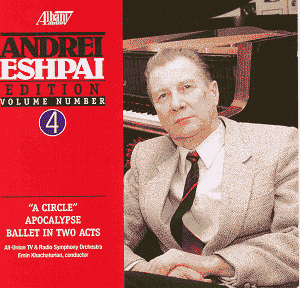The Eshpai home was a gathering place for musicians,
artists, writers and other intellectuals. It was in this environment
that Andrei grew up. In 1928 the family moved to Moscow where
his father attended the Conservatory and his mother the Moscow
Pedagogical Institute. Soon young Andrei began taking music lessons
as well. He studied at Gnessin from 1934 to 1941. He served in
the Soviet Army from 1943-1946. He then returned to the Moscow
Conservatory where he studied the piano and composition with Miaskovsky
and orchestration with Nicolai Rakov. He graduated in 1953 and
entered the post-graduate programme with Aram Khachaturian.
The Circle is a large scale ballet
score deploying a kaleidoscope of ill-assorted styles. To enjoy
this you need to suspend disbelief and be prepared to ride the
roller-coaster. At first we are treated to Karenina-like
innocence which melts into the shades of Ravel's La Valse.
Then comes what seems to be a pastiche of a flute concerto by
Frederick the Great. The next transition jumps fistsful of gears
and launches into what sounds like a pastiche hyper-Hollywood
score from the 1970s with references to Windmills of the Mind
the song from The Thomas Crown Affair. This decays
into a rasping and slashing assault at 10.26 - raucous, viciously
active and very forwardly recorded. It is as if the composer had
shaken the world's styles out of a creative mill and infused each
with the neon glare and blare of Soviet triumphalism and the great
groan at the end of Bolero.
Episodes 3 to 6 include bell-like clangs of painful
immediacy and thumping rhythmic corrugated attacks familiar from
the wild activity of the central movement of Panufnik's Sinfonia
Elegiaca. There are some jazzy 'stings' and ratchety maracas
at 5.09. This is a recording red in tooth and claw and unafraid
of confronting the listener with the full force of yawing and
braying brass (9.40). This continues into the next episode with
the Rózsa-like braying of cohorts of horns and trombones
rising to a racking conflict only terminated by a gong impact.
Act 1 seems to chart a regression from utopian
serenity to the arrival of jazz and of commercial kitsch influences
that signal destruction.
The Second Act opens with flighty magic and childlike
innocence similar to the music in Valery Gavrilin's suite A
House on the Road and Valentin Silvestrov's dreamy vision
in the Fifth Symphony. The innocence is evoked by a toy piano
or amplified harpsichord which lends a music box fragility to
the scene. This is quickly taken into devilish realms by a solo
violin. In Episodes 7-10 innocence is confronted with desolation.
A delightful bossa nova (recalling his 1966 Alexandria)
appears with prominence for guitar and vibraphone and a lushly
treated Caribbean-style melody appears as if John Barry might
have shared one of his ideas with Eshpai. The last episodes move
from the shivering tension of Shostakovich symphonies 10 and 12
in a series of mercurial stylistic swerves - the unabashed juxtaposition
of styles. The candle power is turned up, lights cut across the
sky and the scene is riven with the triumph of Rózsa's
El Cid score mixed with Andrei Petrov's tolling and resounding
bells. The flute of loneliness from the starting brings us full
circle with the score ending in chanted calmness.
This is a startling and enigmatic work which
may disconcert Western listeners. The popular elements reflect
Eshpai’s immersion in mass culture in the 1960s and 1970s with
an operetta, a musical and jazz experiments. Emin Khachaturyan
directs a far from subtle recording of this far from subtle work
in which stylistic gear changes are part and parcel of Eshpai’s
instincts and creative force.
Rob Barnett
